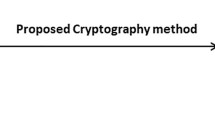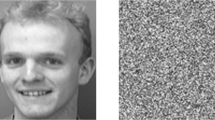Abstract
Cancelable Biometric is a challenging research field in which security of an original biometric image is ensured by transforming the original biometric into another irreversible domain. Several approaches have been suggested in literature for generating cancelable biometric templates. In this paper, two novel and simple cancelable biometric template generation methods based on Random Walk (CBRW) have been proposed. By employing random walk and other steps given in the proposed two algorithms viz. CBRW-BitXOR and CBRW-BitCMP, the original biometric is transformed into a cancelable template. The performance of the proposed methods is compared with other state-of-the-art methods. Experiments have been performed on eight publicly available gray and color datasets i.e. CP (ear) (gray and color), UTIRIS (iris) (gray and color), ORL (face) (gray), IIT Delhi (iris) (gray and color), and AR (face) (color). Performance of the generated templates is measured in terms of Correlation Coefficient (Cr), Root Mean Square Error (RMSE), Peak Signal to Noise Ratio (PSNR), Structural Similarity (SSIM), Mean Absolute Error (MAE), Number of Pixel Change Rate (NPCR), and Unified Average Changing Intensity (UACI). By experimental results, it has been proved that proposed methods are superior than other state-of-the-art methods in qualitative as well as quantitative analysis. Furthermore, CBRW performs better on both gray as well as color images.









Similar content being viewed by others
Explore related subjects
Discover the latest articles and news from researchers in related subjects, suggested using machine learning.References
Prabhakar S, Pankati S, Jain AK (2003) Biometric recognition: security and privacy concerns. IEEE Secur Priv 1:33–42
Manisha, Kumar N (2019) Cancelable biometrics: a comprehensive survey. Artif Intell Rev Springer Netherlands. https://doi.org/10.1007/s10462-019-09767-8
Patel VM, Ratha NK, Chellappa R (2015) Cancelable biometrics: a review. IEEE Signal Process Mag 32(5):54–65
Grady L (2006) Random walks for image segmentation. IEEE Trans Pattern Anal Machine Intell 28(11):1768–1783
Bampis CG, Maragos P, Bovik AC (2016) Graph-driven diffusion and random walk schemes for image segmentation. IEEE Trans Image Process 26(1):35–50
Bertasius G, Torresani L, Yu SX, Shi J (2017) Convolutional random walk networks for semantic image segmentation. In: Proceedings of the IEEE conference on computer vision and pattern recognition, pp 858–866
Murakami T, Fujita R, Ohki T, Kaga Y, Fujio M, Takahashi K (2019) Cancelable permutation-based indexing for secure and efficient biometric identification. IEEE Access 7:45563–45582
Ratha NK, Chikkerur S, Connell JH, Bolle RM (2007) Generating cancelable fingerprint templates. IEEE Trans Pattern Anal Mach Intell 29(4):561–572
Jin Z, Hwang JY, Lai YL, Kim S, Teoh ABJ (2018) Ranking-based locality sensitive hashing-enabled cancelable biometrics: index-of-max hashing. IEEE Trans Inform Forens Secur 13(2):393– 407
Sandhya M, Prasad MV (2016) Securing fingerprint templates using fused structures. IET Biometr 6(3):173–182
Wang S, Hu J (2013) A Hadamard transform-based method for the design of cancellable fingerprint templates. In IEEE International Congress on Image and Signal Processing (CISP) 3(6):1682–1687
Hämmerle-Uhl J, Pschernig E, Uhl A (2013) Cancelable iris-templates using key-dependent wavelet transforms. In: IEEE International conference on biometrics (ICB), pp 1–8
Wang Y, Hatzinakos D (2010) Cancelable face recognition using random multiplicative transform. In IEEE International Conference on Pattern Recognition 20:1261–1264
Pillai JK, Patel VM, Chellappa R, Ratha NK (2011) Secure and robust iris recognition using random projections and sparse representations. IEEE Trans Pattern Anal Mach Intell 33(9):1877–1893
Lingli Z, Jianghuang L (2010) Security algorithm of face recognition based on binary pattern and random projection. In IEEE Cognitive Informatics (ICCI) 9:733–738
Punithavathi P, Geetha S (2016) Dynamic sectored random projection for cancelable iris template. In IEEE International conference on advances in computing communications and informatics (ICACCI), pp 711–715
Pillai JK, Patel VM, Chellappa R, Ratha NK (2010) Sectored random projections for cancelable iris biometrics. In: IEEE International conference on acoustics speech and signal processing, pp 1838–1841
Kim Y, Toh KA (2008) Sparse random projection for efficient cancelable face feature extraction. In IEEE Conference on Industrial Electronics and Applications 3:2139–2144
Manisha, Kumar N (2020) On generating cancelable biometric template using reverse of Boolean XOR. In: Proceedings of international conference on emerging trends in communication, control and computing (ICONC3), Lakshmangarh, Sikar, India,1-4. https://doi.org/10.1109/ICONC345789.2020.9117459
Samaria FS, Harter AC (1994) Parameterisation of a stochastic model for human face identification. In: Proceedings of IEEE workshop on applications of computer vision, pp 138–142
Martinez AM (1998) The AR face database CVC Technical Report24
Kumar A, Passi A (2010) Comparison and combination of iris matchers for reliable personal authentication. Pattern Recogn 43(3):1016–1026
Emersic Z, Struc V, Peer P (2017) Ear recognition: more than a survey. Neurocomputing 255:26–39
Hosseini MS, Araabi BN, Soltanian-Zadeh H (2010) Pigment melanin: pattern for iris recognition. IEEE Trans Instrum Meas 59(4):792–804
Zuo J, Ratha NK, Connell JH (2008) Cancelable iris biometric. In: IEEE 19th international conference on pattern recognition, pp 1–4
Trivedi AK, Thounaojam DM, Pal S (2020) Non-Invertible cancellable fingerprint template for fingerprint biometric. Comput Secur 90:101690
Acknowledgements
We acknowledge Ministry of Human Resource Development, Govt. of India for supporting this research by providing fellowship to one of the authors, Ms. Manisha. One of the authors, Dr. Nitin Kumar is thankful to Uttarakhand State Council for Science and Technology, Dehradun, Uttarakhand, India for providing financial support towards this research work (Sanction No. UCS & T/R & D-05/18-19/15202/1 dated 28-09-2018)
Author information
Authors and Affiliations
Corresponding author
Additional information
Publisher’s note
Springer Nature remains neutral with regard to jurisdictional claims in published maps and institutional affiliations.
Rights and permissions
About this article
Cite this article
Kumar, N., Manisha CBRW: a novel approach for cancelable biometric template generation based on 1-D random walk. Appl Intell 52, 15417–15435 (2022). https://doi.org/10.1007/s10489-022-03215-x
Accepted:
Published:
Issue Date:
DOI: https://doi.org/10.1007/s10489-022-03215-x




